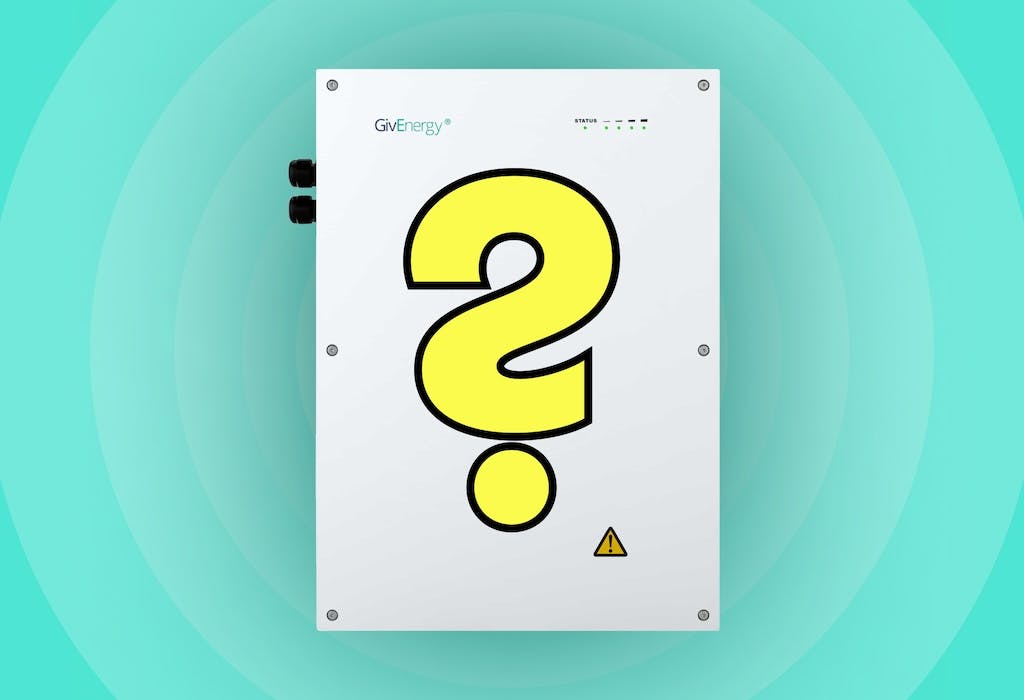- Solar advice hub
- Batteries
- The 5 different types of solar battery
The 5 different types of solar battery
Understand the five main varieties of storage battery in the UK and discover the best one for a solar panel installation.


Why you can trust our content
We know that the solar industry is full of misinformation, but we only use reliable sources, including:
- Our experienced solar experts, installers and system designers
- Our own database of solar & battery system designs
- Authoritative bodies like MCS and the UK government




At a glance
Installing the right battery with your solar panels can make a big difference to your energy bill savings, so it's vital to choose wisely. Read on to learn about the five main types of storage battery and what makes each one special.
If you're curious about how much you could save with a solar & battery system, answer a few quick questions below and we'll get back to you with a personalised calculation.
What are the five types of solar battery?
According to the solar certification body Flexi-Orb, 73% of UK households with solar panels also have a battery, and the vast majority of installers today will include a battery in new systems by default.
Here are the five main types of battery, which we'll explore in more detail below:
- Lead-acid batteries
- Lithium-ion batteries
- Sodium-ion batteries
- Flow batteries
- Nickel-cadmium batteries
1. Lead-acid batteries
Lead-acid batteries are the oldest on our list, having been used since 1859. They’re composed of lead plates submerged in a diluted sulfuric acid electrolyte solution, and have gradually become a less popular choice for residential solar installations.
Benefits of lead-acid batteries
- Cost-effective
- Reliable and established technology
- High recyclability
The materials for lead-acid batteries, primarily lead and sulfuric acid, are widely available and relatively inexpensive, contributing to the battery’s popularity and cost-effectiveness.
Lead-acid batteries have been a reliable way of storing energy for the last 165 years, so their technology is well established and time-tested.
Plus, up to 99% of a lead-acid battery can be recycled, which means their end-of-life environmental impact is pretty low compared to other types, like nickel-cadmium batteries.
Drawbacks of lead-acid batteries
- Shorter lifespan
- Regular maintenance required
- Lower energy density
- Heavier and bulkier
- Environmental hazards
Lead-acid batteries have a fairly short lifespan of around three to seven years, which means you’d have to replace it at least four times across the first 30 years of your solar panels’ lifetime.
They are also fairly high-maintenance, as you will need to replenish their electrolyte levels by adding precise amounts of distilled water on a regular basis.
Lead-acid batteries have a lower energy density than most types of battery, meaning they store less energy per unit of weight, making them heavier and bulkier. This can be a significant disadvantage in situations where both space and weight are important factors.
And although they have high recyclability, lead and sulphuric acid are still toxic materials that will need careful handling and disposal to avoid contamination and health risks.
2. Lithium-ion batteries
Lithium-ion batteries are widely used in residential and commercial solar installations because they offer efficient energy storage, minimal maintenance, and quick charging capabilities.
These batteries are composed of lithium (the primary component), cobalt, nickel, and manganese, which are predominantly mined in Australia, Chile, China, and Argentina.
Lithium-ion batteries are the preferred choice for most solar panel systems because of their high energy density, compact design, long lifespan, and low self-discharge rate.

Benefits of lithium-ion batteries
- High energy density
- Long lifespan
- Fast charging capabilities
- Low maintenance
- Low self-discharge rate
Unlike lead-acid batteries, lithium-ion batteries have a high energy density, which enables them to store more energy in a smaller space. This means they’re particularly versatile in residential applications, where there isn’t always a lot of room.
At 10-12 years, lithium-ion batteries have the highest average lifespan of all battery options and can endure at least 6,000-10,000 charging cycles over those years. In fact, some models can handle unlimited cycles within their first 10 years. They also support fast charging, so they can quickly refill on solar-generated electricity during the brightest part of the day, to be used later in the evening.
Conveniently, lithium-ion batteries have a low maintenance requirement, since there's no need for regular checks or electrolyte top-ups. They also have a low self-discharge rate, which means they’re great at holding onto their stored energy over time.
Drawbacks of lithium-ion batteries
- Higher cost
- Limited lifespan under extreme conditions
- Recycling challenges
Despite their popularity, the initial cost of lithium-ion batteries is higher than most other battery types, which can be a barrier for some.
These batteries are also sensitive to extreme temperatures (i.e., below freezing or above 45°C), which can shorten their lifespan and reduce their efficiency. However, this is rarely a problem in the UK, especially if the battery has been installed correctly and given adequate protection from outside temperatures.
Also, it's complicated to recycle lithium-ion batteries, and it's not widely done, which makes disposing of them an environmental problem. According to a 2022 study, only 5% of lithium batteries are recycled worldwide - although researchers are working on new recycling methods to recover the valuable raw materials.
3. Sodium-ion batteries
Although still in development, sodium-ion batteries are emerging as a more environmentally friendly alternative to lithium-ion batteries. These batteries are mainly composed of sodium, which is easily found in natural saltwater, along with other elements like manganese, nickel, and iron.
The downside is that sodium-ion batteries have a lower energy density and don't last as long as lithium-ion batteries. But they are scalable and don't rely on rare resources, which makes them a promising option for storing energy in the future.
Benefits of sodium-ion batteries
- Abundant and inexpensive materials
- Environmentally friendly
- Early signs of safety
Sodium, sourced from common resources like seawater and mineral deposits, is abundant and inexpensive. This makes sodium-ion batteries a more cost-effective alternative to lithium-ion batteries.
Since sodium is chemically similar to lithium, sodium-ion batteries work the same way and can offer similar efficiency and capacity.
A 2024 study (Bhutia et al.) also found that some sodium-ion batteries performed well in early safety tests, showing no flames during extreme conditions like overheating or short circuits. This is encouraging potential, but researchers are still looking into how to improve the materials to make them safer and more stable.
Drawbacks of sodium-ion batteries
- Lower energy density compared to lithium-ion
- Larger and heavier than most batteries
- Shorter lifespan
- Not yet available
Despite their promising benefits, sodium-ion batteries have 30% less energy density compared to lithium-ion batteries, which makes them large and heavy like lead-acid batteries.
Most importantly, sodium-ion batteries aren't yet widely available, as they are still undergoing significant research and development. Their lifespan is also a lot shorter than lithium-ion batteries, as they can only perform around 3,000 cycles in their lifetime.
These challenges need to be addressed before sodium-ion batteries can become a mainstream energy storage solution.
4. Flow batteries
Flow batteries have a distinctive design that involves the use of two liquid electrolytes, commonly containing vanadium or zinc-bromine, for energy storage. These electrolytes are stored in separate tanks and are circulated through a cell stack to produce electricity.
Vanadium is primarily mined in South Africa, China and Russia, but it's twice as expensive to process than lithium, whereas zinc-bromine can be sourced from various mineral deposits worldwide.
A flow battery's scalability and long lifespan make it perfect for solar energy storage projects on a large scale - but not so much for household usage, given its high cost and complexity.
Benefits of flow batteries
- Safest battery type
- Long lifespan
- Minimal degradation over time
- Consistent energy output
- Scalable
Given that the liquid electrolyte solutions in a flow battery contain a high concentration of water, they are inherently less likely to suffer from thermal runaway and catch fire than all other battery types. Some flow batteries do use corrosive or toxic liquids, but this isn’t essential as there are several safe alternatives.
Flow batteries boast a long lifespan of at least 20 years, capable of around 15,000-20,000 charging cycles with minimal degradation.
These batteries also deliver a consistent power output, and owners can easily expand their capacity by increasing the size of the electrolyte tanks.
Drawbacks of flow batteries
- Expensive to install and maintain
- High maintenance requirements
- Large and heavy
- Lower energy density
Flow batteries are significantly more expensive than other battery storage options, which can be a barrier for smaller projects or budget-conscious applications.
The system's complex design, involving pumps, tanks, and plumbing, will need specialised technical knowledge for installation and maintenance, which will add to the overall cost.
Flow batteries also have a lower energy density compared to other types of batteries and a large physical footprint, which isn't practical for households with limited space.
5. Nickel-cadmium batteries
Nickel-cadmium (Ni-Cd) batteries are made of nickel oxide hydroxide and metallic cadmium as electrodes. These materials are sourced from nickel and cadmium ores, primarily mined in Canada, Russia, and Australia.
Household Ni-Cd batteries were banned from use in the EU and the UK as of December 2016, aside from a few limited exemptions for industrial use, emergency alarms, and specific medical equipment. And to ensure further safety, these batteries can't contain more than 0.002% of cadmium, by weight.
Ni-Cd batteries still have widespread use in the railway and aviation sectors, especially in Asia. Despite the hazards, they come with a long lifespan and can handle deep discharge cycles.
Benefits of nickel-cadmium batteries
- High durability
- Perform well in extreme temperatures
- Deep discharge capability
- High energy density
- Rapid charging
Ni-Cd batteries can withstand rough handling and severe conditions, making them ideal for industrial and military use. They perform exceptionally well in extreme temperatures (from −40°C to +70°C) where other battery types usually fail, and their capacity remains largely unaffected even after many deep discharge cycles.
Ni-Cd batteries also have a relatively high energy density and allow for fast charging.
Drawbacks of nickel-cadmium batteries
- Banned in the UK
- Toxic to humans and the environment
- Prone to the memory effect
There’s no way to get your hands on a Ni-Cd battery in the UK for domestic purposes, as it contains banned materials - and that’s for a good reason, as cadmium is extremely harmful to humans and the environment. This also means that the Ni-Cd batteries used for industrial and medical purposes come with special disposal requirements.
Ni-Cd batteries are also prone to something called the “memory effect”. The memory effect refers to when a battery loses its effective capacity over time if repeatedly discharged without fully recharging first - essentially, the battery remembers the "not full" capacity and only recharges to that level.
What’s the best type of solar battery?
The best type of battery for a solar panel system is lithium-ion, thanks to its outstanding performance and reliability.
With its large capacity, impressive efficiency of at least 95%, and quick charging and discharging capabilities, the lithium-ion battery far outstrips the other candidates in this article. It also stands out for being smaller and lighter than other options, making it well-suited for most homes.
To find out how much a solar & battery system could save you on your energy bills, answer a few quick questions below and we’ll get back to you with an estimate.
Solar battery types: FAQs
Related articles

Are solar batteries worth it?
Read full story
What size solar battery do I need?
Read full story
5 reasons to get a larger storage battery
Read full story
How long do solar batteries last?
Read full story
Written byMelody Abeni
Based in London, Melody is a specialist green technology writer who has been covering sustainability, climate action and ESG for the past five years, after gathering operational experience in green investing and financial services. She has written for various industry publications, including renewable technology advisor The Eco Experts, and she holds a Master’s degree in law from Birkbeck University.